“Been in America”: Interviews with German researchers in the USA and Canada
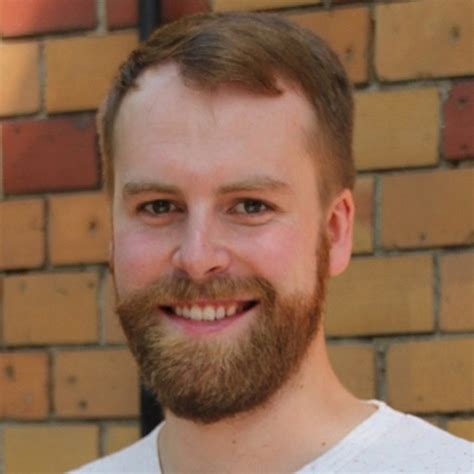
Dr.-Ing. Henning Bonart
© privat
(07/19/22) Through its research fellowship program, and since 2019 through the Walter Benjamin Programme, the DFG supports junior scientists in their academic careers by funding an independent research project either abroad or in Germany. A large proportion of these fellowships are awarded in the USA and Canada, thereby reflecting the belief still prevalent in many disciplines – and in the life sciences in particular – that for a career in research it is helpful to have “been in America.” In a series of talks, we aim to give you an impression of the wide range of DFG funding recipients. In this edition we take a look at who is behind funding number BO 5908.
DFG: Dr. Bonart, thank you so much for taking the time to talk to the DFG. Your family name sounds as if it might be French, but your biography says you were born in Marl.
Henning Bonart (HB): Yes, there is some suspicion that some of our family ancestors may have been Huguenots, but I don’t think anyone has seriously checked that out yet. Nonetheless my wife has been taken for French at the doctor’s office more than once. I’m very glad to be able to talk to you and of course grateful to the DFG for enabling me to stay in the USA with my family and conduct research at MIT.
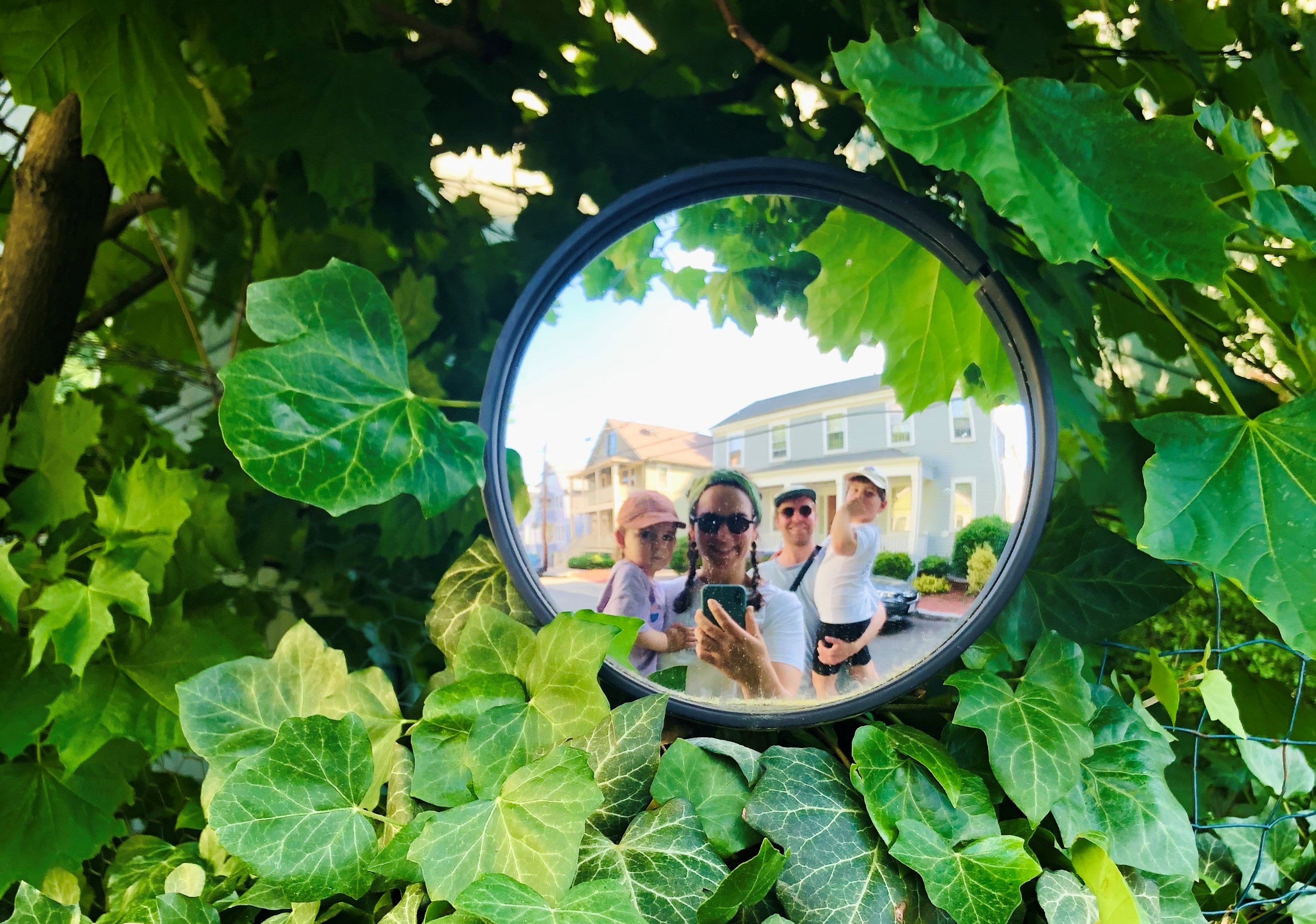
The whole family
© privat
DFG: Before we go into that, let’s talk briefly about how you got there -- in other words, what it was that set you on the path to process engineering and research.
HB: As regards chemistry, there is something of a family tradition that goes back a generation or two. One of my two grandfathers worked as a physicist for several years at Bayer AG in Leverkusen, while the other grandfather passed his journeyman’s examination as an electrician at Hoechst AG in Frankfurt. My father worked for some time for Hüls AG in Marl and in the US, in Piscataway, NJ. That’s why I was born in Marl and went to the USA with my family at an early age. Hoechst has been part of the Sanofi Group since the 1990s and large parts of Hüls AG have been absorbed into the present-day Evonik AG. All this almost certainly will have had some kind of impact on me, and on my brothers, too. Economics, science, mathematics and technology are very important to all of us.
I grew up in Trier on the Mosel River. When I was at upper secondary school, I was actually looking to study medicine, so I had German, biology and sport as my main subjects. Fortunately, to this day both literature and sport have remained with me as a counterbalance – not least thanks to my mother, who is a sports and social studies teacher. After taking my school-leaving exams, however, I quickly switched to technology and did a voluntary ecological year instead of civil service. For this I went to the Berliner Energieagentur – an institution that taps energy-saving potential, in particular in buildings and the way they’re operated. Berlin was my favorite city at that time – and probably still is. There are lots of reasons for this, the excellent public transport system certainly being one of them. I love travelling through cities by bus or train and have been able to inspire my two sons to love it, too: one of them was actually born in Berlin, the other is a “Heiner” – which is what people born in Darmstadt are known as! Fortunately, Greater Boston also has a pretty good public transport system.
I then went on to study at the Karlsruhe Institute of Technology (KIT) together with my girlfriend, who is now my wife. I did my bachelor’s degree in chemical and process engineering there between 2009 and 2012. In order to do my master’s and doctorate – and of course to ride the underground – we went back to the capital in 2013, where I was at Technische Universität Berlin. Even during my doctoral studies, I spent three months at MIT in 2019 with my wife and eldest son on a DAAD scholarship. In January 2021, I received my doctorate with a thesis on the simulation and optimization of fluids on surfaces of solids. Because of the pandemic, the oral examination took place online, live from my living room in Darmstadt – I’d been at Technische Universität Darmstadt and the Max Planck Institute for Polymer Research in Mainz since the previous summer. I’ve held my own Walter Benjamin position at TU Darmstadt since June 2021.
DFG: In your doctoral thesis, as in many areas of physics, chemistry and technology, one key point always seems the length scales that are being referred to. Was this relevant for you, too?
HB: Nature doesn’t make any such divisions, of course, but for us it’s useful to think about the time and length scales of the processes as this has the potential to simplify the questions we pursue. Not all effects and forces have a role to play in the process on every scale. However, this classification is quite arbitrary and so it isn’t clear-cut. In fluid process engineering, we can often break down the question into the three essential groups of macro, micro and nano. Macro means entire apparatuses such as distillation columns or reactors. Here we often neglect the microscopic relationships, e.g. processes directly at the phase boundaries between liquid and vapor. These are a major factor in microfluidics. We’re talking about length scales of a few millimetres to micrometres here, i.e. one thousandth of a millimetre. In the case of small drops or thin films of liquid, capillary forces and surface tension are vital. Nano goes down another level, also considering such things as individual molecules in flows.
I’m particularly interested in the microscale, i.e. sliding drops on microstructured surfaces or thin, vibrating films, as well as flows in microchannels. There’s so much to discover here and there’s still a lot to explain in terms of effects. The impact on processes is enormous, enabling lots of fascinating applications; these include highly sensitive microfluidic biosensors for the detection of viruses or slipping droplets as an electrical generator or bioreactor.
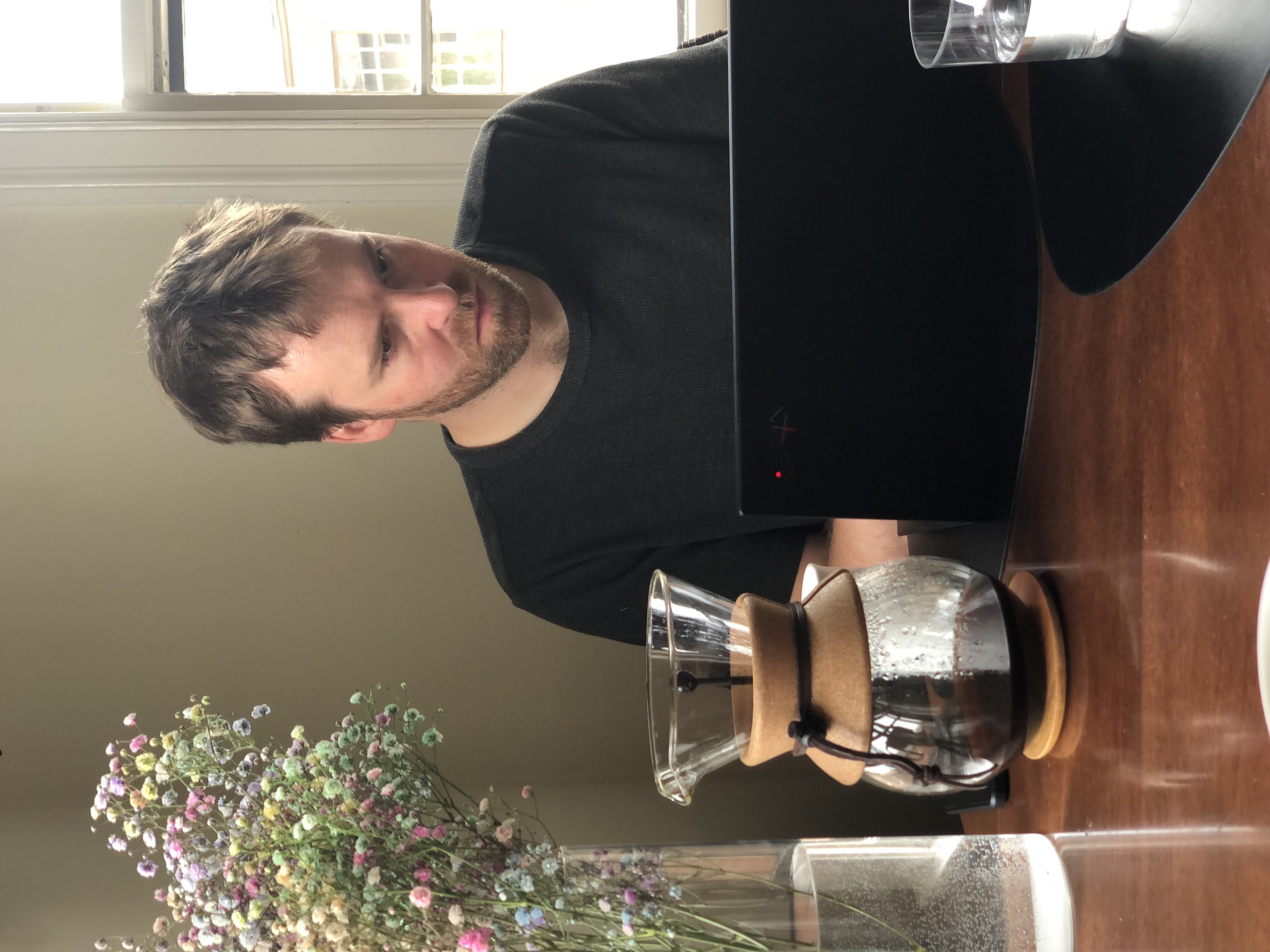
Working at home with Covid
© privat
DFG: Nonetheless, your doctoral thesis looks more like applied mathematics. And in your ongoing Walter Benjamin project, statistics also seems to be a major area of interest. How does that fit in with microfluidics?
HB: That’s right -- I didn’t do a single laboratory experiment for my doctorate – but I did do lots of computer experiments. For example, I calculated the movement of drops using mathematical models on the computer. These models can be derived from basic physical principles and often provide a very good representation of reality. Solving these equations is very difficult and time-consuming. But if it works, you save yourself the expense of a laboratory experiment. In addition, I can use the models and solutions to design drop movement control units, for example. These control units can then be used in experiments. Which brings me to the statistics in my Walter Benjamin project. If you want to close the loop between the simulation of the model and real-world experiments, you quickly run into the problem that the experimental data are error-prone and the mathematical models are not quite perfect. The field of Uncertainty Quantification provides statistical methods to systematically quantify and then reduce these measurement errors and uncertainties. In this way we can find out where we should be repeating our measurements, for example, so we can make a reliable statement about an observed effect. And we don't just make predictions about effects, we also say how sure we are about the prediction. Like Thomas Bayes, who might say with regard to the question of whether it will rain tomorrow or not: I am 80% sure it will rain tomorrow.
DFG: Being from Wuppertal, that’s definitely something I can relate to: children there are born with umbrellas, and you’re even asked how sure you are of a forecast if you predict sunshine.
HB: It’s interesting you mention children: they’re a great way of explaining Bayes’ logic. If you look up his name you’ll find he was an 18th century English statistician, philosopher and clergyman. He described a basic formula for calculating conditional probabilities, and his theorem provides a systematic way of adapting hypotheses or statements to real-life experience – something I’m able to observe in both my children on a daily basis. Our eldest will be five in August and our second child turns two in October. Even the younger one has come to learn that if he breaks an assembled Lego kit belonging to his brother, the latter will get annoyed. But that took some experience to find out. Meanwhile, the older one has learned not to leave his models lying around, as otherwise there is a high probability of an “accident” occurring – i.e., an intervention by his younger brother. So both of them have calibrated their respective ideas of how things work based on experience. And that’s exactly what we’re seeking to do in my research project.
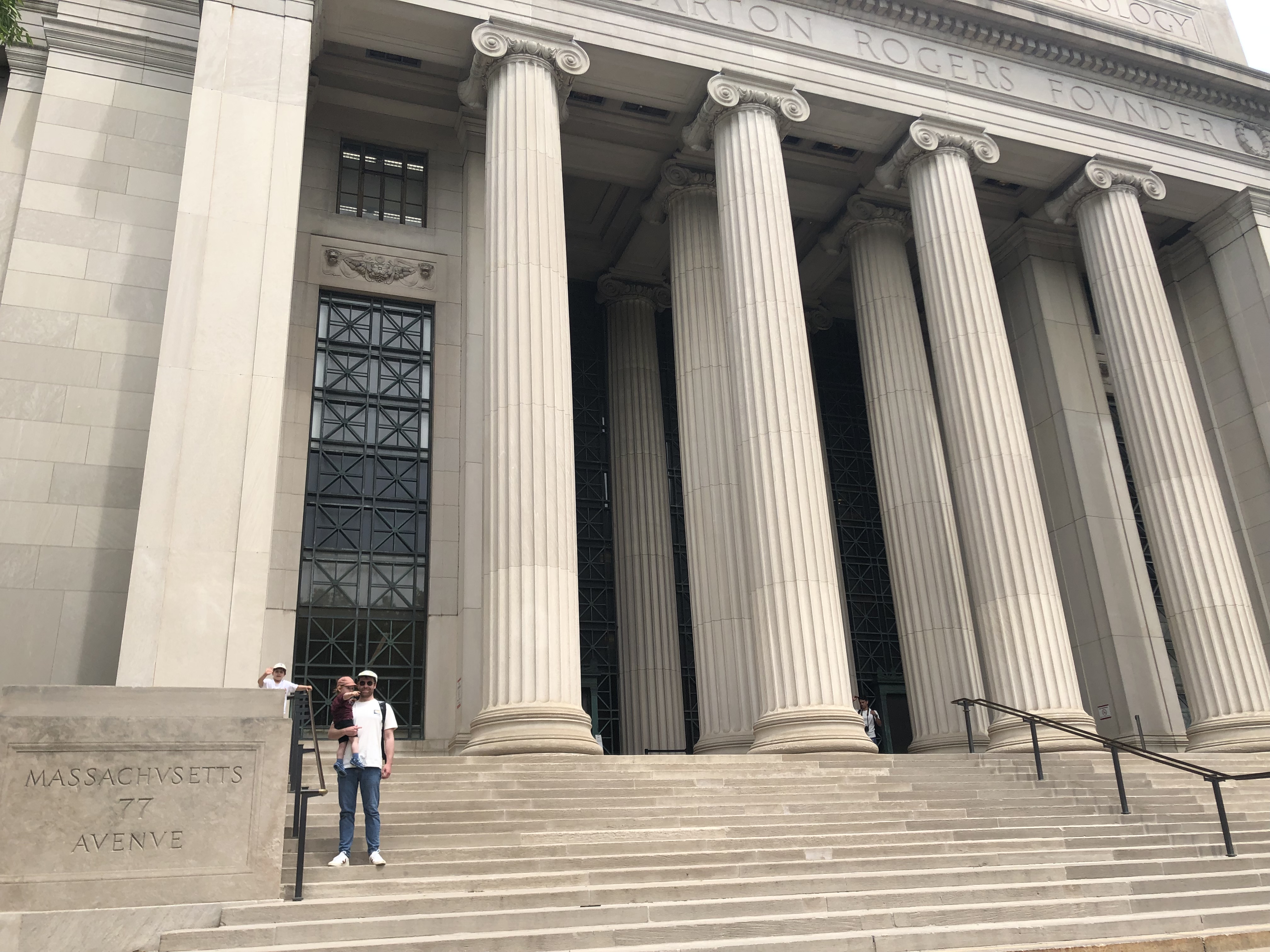
With both kids in front of MIT, 77 Massachusetts Ave.
© privat
DFG: Now you’re sounding more like a behavioral economist than a process engineer.
HB: That is probably because Bayesians are much more common among economists, sociologists and social scientists than among process engineers. Bayes often crops up in weather forecasting, too. However, my impression is that statistics is not something engineers are particularly familiar with at all – and if they do venture into that domain, they tend to express themselves in a rather complex way. But in fact Bayesian statistics is very intuitive and generates easily interpretable probability statements. It’s closer to everyday language use and the intuitive concept of probability, so it’s perfect for engineers. I'd actually never heard of Bayes before, at least not until three years ago: it was Youssef that made me aware of him.
DFG: You’re now once again a member of Youssef Marzouk’s Uncertainty Quantification Group at MIT. What does this collaborative work involve?
HB: The group here is very interested in developing and improving methods for solving complex Uncertainty Quantification (UQ) problems – and it’s very successful at this, too. This fortunately means I don’t have to reinvent all the methods – nor would I be capable of doing so. As an engineer, I see my role at the interface between mathematical methods and microfluidic research. My aim is to show that these modern Bayesian UQ methods can also provide answers to microfluidic questions from Darmstadt or Berlin. It helps that the Marzouk group here at MIT is part of the Department of Aeronautics and Astronautics, which means that it’s also able to tackle engineering issues. So the people here know a lot about fluid dynamics and are very interested in the topic. The discussions are very pleasant and productive. My expertise – and this is what I did my doctorate on – lies more in the area of multiphase fluid dynamics. In this way, we can learn from each other here and work on interdisciplinary issues that none of us could solve on their own.
DFG: Which complicated processes are you currently seeking to make statements about and what processes are you aiming to improve?
HB: I’d like to keep things general first so as to enable transfer to a wide range of problems in microfluidics. For demonstration purposes, we use two different examples, each with laboratory experiments. In the first case, the aim is to find a predictive model for the stability of holes in thin liquid films on vibrating surfaces. Knowledge about hole stability is important when coating or cleaning surfaces, for example. To do this, we combine measurement data with a statistical description of the measurement errors and compare different models. In the second case, an automated detection scheme is developed from noisy measurement data of samples transported at low concentration in microchannels. For this purpose, the behaviour of the detector is described statistically so as to enable traceable and transparent decisions in conditions of uncertainty. This allows the automation of microfluidic detection schemes in medical diagnostics or high-throughput screening applications, for example.
DFG: And you’re looking to manage all this in the course of the next eight months – as well as moving your family and settling into a new environment in Cambridge, Massachusetts?
HB: No, the stay at MIT is only one part of my two-year Walter Benjamin project. Before I came here, I’d already spent 11 months in Darmstadt conducting laboratory experiments and developing models. The eight months will hopefully be sufficient for the planned work packages here at MIT. But I’m spending a significant part of the time for my Walter Benjamin project at the TU Darmstadt. Of course, moving and settling in with family is an added burden, especially now with the pandemic. The fact that it’s working has a lot to do with my wife, who is very helpful and supportive. My eldest son goes to a childcare centre at MIT two days a week, funded by the DFG. We have now settled in well, but the biggest stress factor is still money. The Boston area is extremely expensive, inflation is high and the exchange rate is poor. Nonetheless, all in all we’re already seeing that this will be a wonderful and successful stay with lots of unforgettable experiences and memories. My period at MIT with all the discussions, seminars and networking was itself a catalyst for lots of new ideas for myself and my research in 2019, and the same is true again now. After that, I will resume my Walter Benjamin post in Darmstadt.
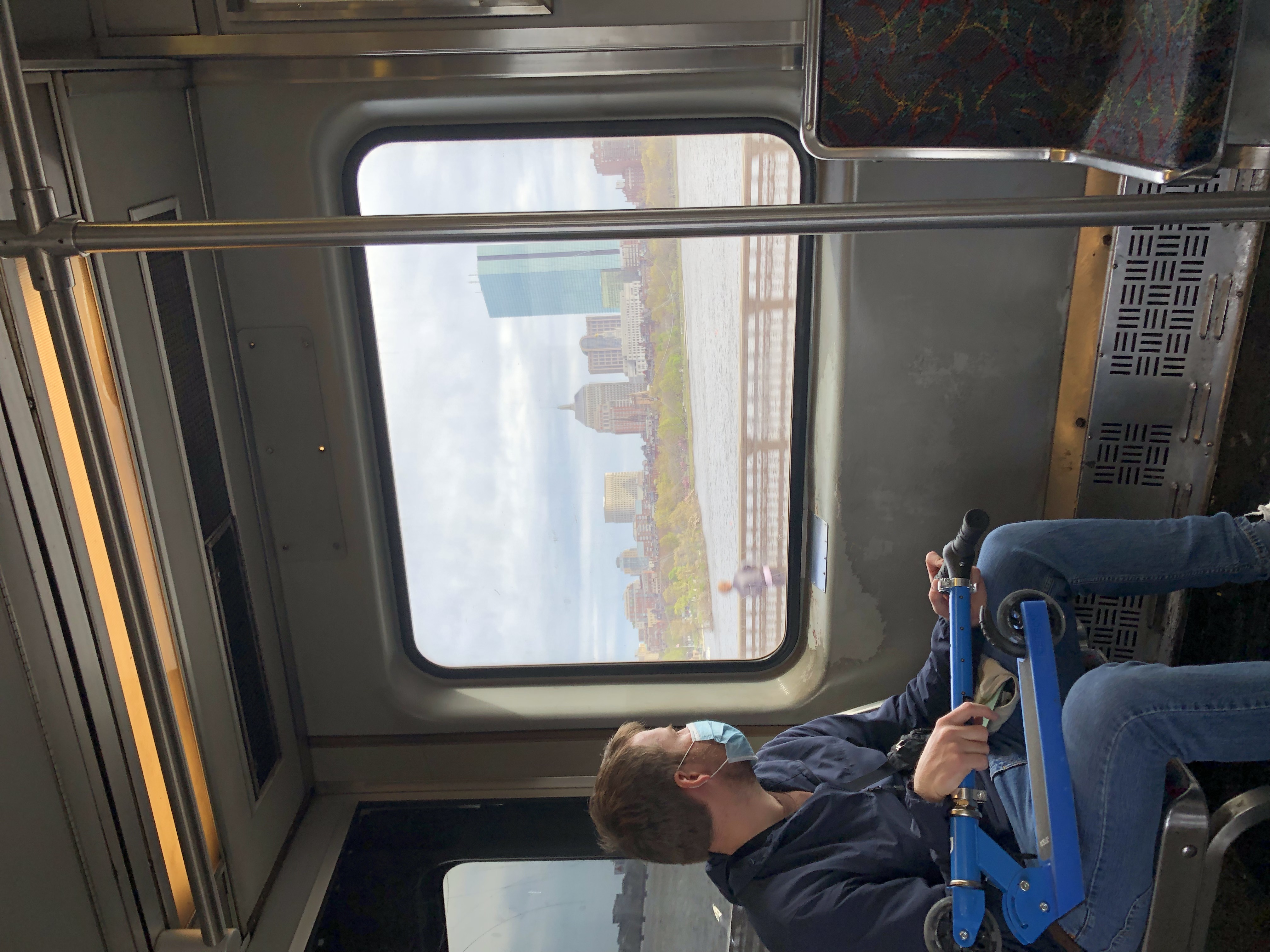
On the Red Line with Boston in the background
© privat
DFG: Is that where you want to continue your career after the Walter Benjamin project comes to an end?
HB: That’s not definite yet. My life to date has already had something of a nomadic tinge, which is why it’s difficult for me to imagine myself in one place for a long time. And it’s not just about me of course, but also my wife and her interests. A mixture of city and countryside would be good because of the children – the compatibility of work and family is very important to me. So which city it turns out to be will depend on various factors, both private and professional. A move to the USA for a few years wouldn’t be out of the question either. But first of all I want to come up with some interesting research outcomes and get them published. I enjoy the university with its open-minded, international research environment and I’d like to lead a team of researchers soon. At the moment I’m thinking about applying for a junior research group leadership. As an engineer with a doctorate, I’m as interested in technical improvements as I am in broadening underlying knowledge. There are a number of places where this can be done in Germany – and Darmstadt seems to me to be one of the best suited. Nonetheless, there are certainly other places in Germany where you can find excellence in one area and a combination of basic research and application. At the same time, I’d also like to have greater planning security regarding my future at university – so I’ve often considered switching to the chemical or pharmaceutical industry, too. There is some very interesting and useful research being done in that sector. I think I’d be very happy as a team leader in a company, too.
DFG: As you see it, what are the differences between German centers of excellence and Cambridge, i.e. the place where MIT and Harvard University are located?
HB: In Cambridge you’ll probably find the world’s greatest concentration of talent in many areas of the life sciences, the natural sciences and engineering. The list of top institutions in the Boston area is long. And a lot of money is spent here. Harvard has recently acquired a huge new engineering building; MIT has the College of Computing. That kind of thing doesn’t just appear out of nowhere in other places. In addition, you see a lot of money being invested here in response to new findings, developments, and emerging topics in research and teaching. On the other hand, there’s probably an optimum degree of compression which you can’t add to. Cambridge may well be at that optimum – or perhaps it’s already passed that point and people are operating more efficiently elsewhere. For me, the question is always how many people I can effectively collaborate with. Covid has certainly taught us a lot more about video conferencing. You don’t necessarily have to be in the same place all the time to be able to engage in sound collaboration. So all in all, there are lots of excellent opportunities to conduct research in Europe and Germany. But a certain degree of planning security is required for early-career investigators. For me in particular, the appeal of the research location is very dependent on what opportunities are available for early-career academics. There are specific advantages and disadvantages in the comparison between the USA and Germany. My personal impression is that it’s easier to get an assistant professor position in the USA than it is to get a junior research group leader position in Germany. On the other hand, as a postdoc in the USA you’re perhaps that bit more dependent on your research group leader. However, our lives are currently centered on Germany – that’s where we have our families and friends. And I really like the diversity of Europe, too.
DFG: One last question: what is it that makes you laugh?
HB: My two children – I laugh about them and I love enjoying a laugh with them, too. They’re a couple of real chatterboxes. Though there are times when I’m just glad to see the kids in bed at night. That’s when I like to watch a TV series with my wife – right now 30 Rock and The Office – and eat Trader Joe’s mint chip ice cream. Laughing and enjoying food together is a wonderful thing.
DFG: Thank you for this interesting and very entertaining interview and we wish you all the very best for the future.